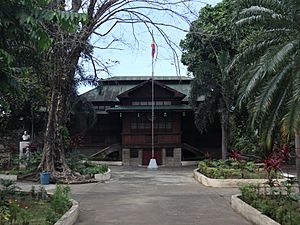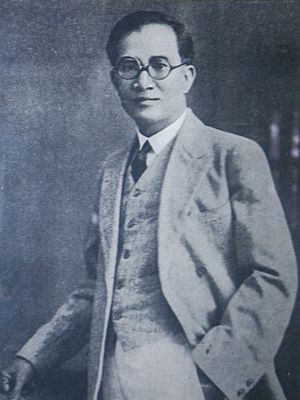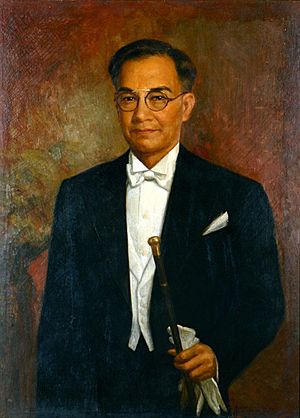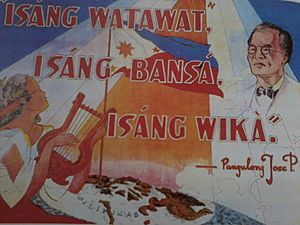Jose P. Laurel facts for kids
Quick facts for kids
Jose P. Laurel
CCLH, KGCR
|
|
|---|---|
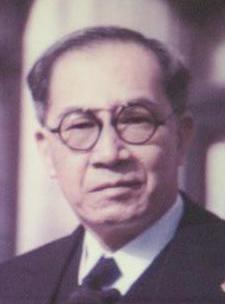
Jose P. Laurel in 1943
|
|
| 3rd President of the Philippines | |
| In office October 14, 1943 – August 17, 1945 Serving with Manuel L. Quezon (1943–1944) and Sergio Osmeña (1944–1945)
|
|
| Prime Minister | Jorge B. Vargas |
| Vice President |
|
| Preceded by | Manuel L. Quezon |
| Succeeded by | Sergio Osmeña |
| Minister of the Interior | |
| In office December 4, 1942 – October 14, 1943 |
|
| Presiding Officer, PEC | Jorge B. Vargas |
| Preceded by | Benigno Aquino Sr. |
| Commissioner of Justice | |
| In office December 24, 1941 – December 2, 1942 |
|
| Presiding Officer, PEC | Jorge B. Vargas |
| Preceded by | Teófilo Sison |
| Succeeded by | Teófilo Sison |
| Senator of the Philippines | |
| In office December 30, 1951 – December 30, 1957 |
|
| Constituency | At-large |
| In office 1925–1931 Serving with Manuel L. Quezon
|
|
| Preceded by | Antero Soriano |
| Succeeded by | Claro M. Recto |
| Constituency | 5th district |
| 34th Associate Justice of the Philippine Supreme Court | |
| In office February 29, 1936 – February 5, 1942 |
|
| Appointed by | Manuel L. Quezon |
| Preceded by | George Malcolm |
| Succeeded by | Court reorganized |
| Senate Majority Leader | |
| In office 1928–1931 |
|
| Senate President | Manuel L. Quezon |
| Preceded by | Francisco Enage |
| Succeeded by | Benigno S. Aquino |
| Secretary of the Interior | |
| In office February 9, 1923 – July 17, 1923 |
|
| Preceded by | Teodoro M. Kalaw |
| Succeeded by | Felipe Agoncillo |
| Undersecretary of the Interior | |
|
Ad interim
|
|
| In office May 22, 1922 – February 9, 1923 |
|
| Personal details | |
| Born |
José Paciano Laurel y García
March 9, 1891 Tanauan, Batangas, Captaincy General of the Philippines |
| Died | November 6, 1959 (aged 68) Manila, Philippines |
| Resting place | Tanauan, Batangas, Philippines |
| Political party | Nacionalista |
| Other political affiliations |
KALIBAPI (1942–1945) |
| Spouse |
Pacencia Hidalgo
(m. 1911) |
| Children | José B. Laurel Jr. José S. Laurel III Natividad Laurel-Guinto Sotero Laurel II Mariano Laurel Rosenda Laurel-Avanceña Potenciana Laurel-Yupangco Salvador Laurel Arsenio Laurel |
| Alma mater | University of the Philippines Manila (LL.B) University of Santo Tomas (LL.M) Yale University (S.J.D) |
| Signature | |
José Paciano Laurel y García (March 9, 1891 – November 6, 1959) was a Filipino politician, lawyer, and judge. He served as the president of the Second Philippine Republic from 1943 to 1945. This government was set up during World War II when Japan occupied the Philippines.
Since the 1960s, Laurel has been officially recognized as a former president of the Philippines. He is remembered for leading the country during a very difficult time.
Contents
Early Life and Education
José Paciano Laurel y García was born on March 9, 1891, in Tanauan, Batangas. His parents were Sotero Laurel y Remoquillo and Jacoba García y Pimentel. His father was an official in the government of Emilio Aguinaldo.
Laurel went to school in Tanauan and later in Manila. He finished high school in 1911. He earned his law degree from the University of the Philippines College of Law in 1915. He passed the Philippine bar exam that same year, placing second.
He continued his studies, getting a Master of Laws degree from University of Santo Tomas in 1919. Laurel then received a scholarship to Yale Law School in the United States. He earned his advanced law degree (J.S.D.) there in 1920. He also studied international law in England and France.
Early Public Service
Laurel started working in public service while he was still a student. He worked as a messenger and a clerk in government offices. He helped with the process of writing Philippine laws.
In 1921, Laurel also became a lecturer at the University of the Philippines. In 1922, he was appointed Undersecretary of the Interior Department. He was later promoted to Secretary of the Interior in 1923.
In this role, he often disagreed with the American Governor-General, Leonard Wood. Laurel and other Cabinet members resigned in protest of Wood's leadership. These disagreements showed Laurel's strong belief in Filipino nationalism.
Political Career in the Philippines
In 1925, Laurel was elected to the Senate of the Philippines. He served one term before losing his re-election in 1931.
He then worked as a private lawyer. In 1934, he was elected as a delegate to the 1935 Constitutional Convention. He helped write the 1935 Constitution, especially the parts about the Bill of Rights.
After the Constitution was approved, Laurel was appointed as an Associate Justice of the Supreme Court of the Philippines in 1936.
Supreme Court Justice
Laurel's time on the Supreme Court was very important for Philippine law. He wrote many key decisions that are still studied today. These decisions helped define the powers of the different branches of government.
One of his most important contributions was the case Angara v. Electoral Commission. This case established that courts in the Philippines have the power to review actions of other government branches. This is called judicial review. It means courts can decide if a law or action follows the Constitution.
Another important decision was Ang Tibay v. CIR. In this case, the Court said that even in administrative cases (like those about workers' rights), people must still be treated fairly. This is known as due process of law.
Laurel also held other government positions while serving as a justice. He was appointed to committees that worked on moral and legal codes. His time as an associate justice ended in February 1942.
Cabinet Member and Path to Presidency
Because Laurel had been critical of American rule, Japanese officials saw him as someone they could work with. When Japan invaded the Philippines, they asked him to join a provisional government.
On December 10, 1941, President Manuel L. Quezon appointed Laurel as acting Secretary of Justice. The Japanese later appointed him Commissioner of Justice in January 1942. In December 1942, he became the Minister of the Interior. He left this position in October 1943 when he became president.
President Quezon had told Laurel and other officials to stay in the Philippines when the Japanese invaded. Laurel cooperated with the Japanese, unlike some others who refused.
Assassination Attempt
On June 5, 1943, Laurel was playing golf when he was shot four times. The bullets narrowly missed his heart and liver. He was rushed to the hospital and recovered quickly.
Presidency During World War II
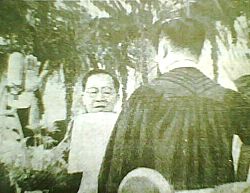
Laurel's presidency is a debated topic in Philippine history. After the war, some people called him a "war collaborator" because he worked with the Japanese. However, he was later granted amnesty (a pardon) by President Manuel Roxas.
When Japan invaded, President Manuel L. Quezon left the Philippines to set up a government-in-exile. Quezon ordered Laurel and other cabinet members to stay. Laurel had good relationships with Japanese officials, which helped him interact with the occupation forces.
The National Assembly, influenced by Japan, chose Laurel as president in 1943. He took office on October 14, 1943, in Manila.
Domestic Challenges
During Laurel's time as president, the biggest problem was hunger. Prices for basic goods became extremely high. The government tried to increase food production and control prices. However, the Japanese occupation made things very difficult.
Guerrilla activities (resistance fighters) and Japanese actions also made the country unsafe. The Japanese often arrested people without clear reasons. This made Laurel's job very challenging and dangerous.
Foreign Relations
On October 20, 1943, the Philippines and Japan signed a treaty of alliance. This treaty did not require Filipinos to join the Japanese army.
Laurel also attended the Greater East Asia Conference in Tokyo in November 1943. This was a meeting of leaders from countries in Asia that were allied with Japan.
Martial Law
In 1944, Laurel declared martial law in the Philippines. This meant the military took control of the government. He did this on September 21, 1944. The next day, he declared that the Philippines was at war with the United States and the United Kingdom.
Filipinization of the Catholic Church
Laurel tried to get the Holy See (the Vatican) to recognize the new Philippine Republic. He also asked the Pope to appoint more Filipinos to leadership roles in the Catholic Church.
Resistance to the Government
Because Laurel's government was linked to Japan, many Filipinos resisted it. They continued to support the exiled Philippine Commonwealth government.
End of the Second Republic
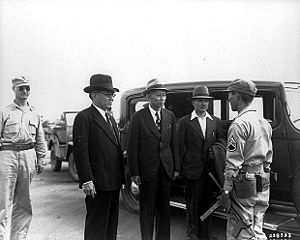
In July 1945, the Allied forces told Japan to surrender or face destruction. Japan refused. On August 6, 1945, the United States dropped an atomic bomb on Hiroshima. Another bomb was dropped on Nagasaki on August 9. Japan surrendered on August 15, 1945.
In March 1945, President Laurel and his family moved to Japan. On August 17, 1945, from Nara, Japan, Laurel announced that his government was dissolved.
Jose P. Laurel is the only Philippine president who served in all three branches of government: as a senator (legislative), a Supreme Court justice (judicial), and a president (executive).
Life After the Presidency
Trial and Imprisonment
After Japan surrendered in September 1945, Gen. Douglas MacArthur ordered Laurel's arrest. Laurel was arrested for working with the Japanese. He was imprisoned in Yokohama, Japan, and later in Sugamo Prison. While in prison, he wrote his Memoirs.
In July 1946, Laurel was sent back to the Philippines. He was charged with 132 counts of treason. However, his trial ended when President Manuel Roxas granted a general amnesty in 1948.
1949 Presidential Election
Laurel ran for president again in the 1949 election. He was the candidate for the Nacionalista Party. He lost to Elpidio Quirino in what was considered a very unfair election.
Return to the Senate

In 1951, Laurel was elected to the Senate of the Philippines again. He received the most votes. He was asked to run for president in 1953 but chose not to. Instead, he supported Ramon Magsaysay, who won the election.
Magsaysay asked Laurel to lead a group to negotiate with the United States. This led to the Laurel–Langley Agreement, which dealt with trade and other issues. Laurel also worked to make José Rizal's novels, Noli Me Tángere and El filibusterismo, required reading in colleges.
Retirement and Death
Laurel saw his election to the Senate as proof that his reputation was restored. He decided not to run for re-election in 1957. He retired from public life. He focused on developing the Lyceum of the Philippines, a school founded by his family. He also worked with the Philippine Banking Corporation, which he had established.
In 1958, Laurel started an organization called the Committee of Citizens. On his 68th birthday in 1959, President Carlos P. Garcia gave him the Philippine Legion of Honor award.
On November 6, 1959, Jose P. Laurel passed away in Manila. He died from a heart attack and brain hemorrhage. He was buried in Tanauan, Batangas.
Honors
National Honor
Personal Life and Family
Jose P. Laurel married Pacencia Hidalgo on April 9, 1911. They had nine children:
- Jose Bayani Laurel Jr. (1912–1998), who became a Congressman and Speaker of the House of Representatives.
- Jose Sotero Laurel III (1914–2003), who served as ambassador to Japan.
- Natividad Laurel-Guinto (born 1916).
- Sotero Cosme Laurel II (1918–2009), who became a Senator.
- Mariano Antonio Laurel (1922–1979).
- Rosenda Pacencia Laurel-Avanceña (born 1925).
- Potenciana "Nita" Laurel-Yupangco (born 1926).
- Salvador Roman Laurel (1928–2004), who became Vice President and Prime Minister.
- Arsenio Laurel (1931–1967), a famous race car driver.
Many of Jose P. Laurel's descendants have also become involved in politics, law, business, and the arts.
See also
 In Spanish: José P. Laurel para niños
In Spanish: José P. Laurel para niños


